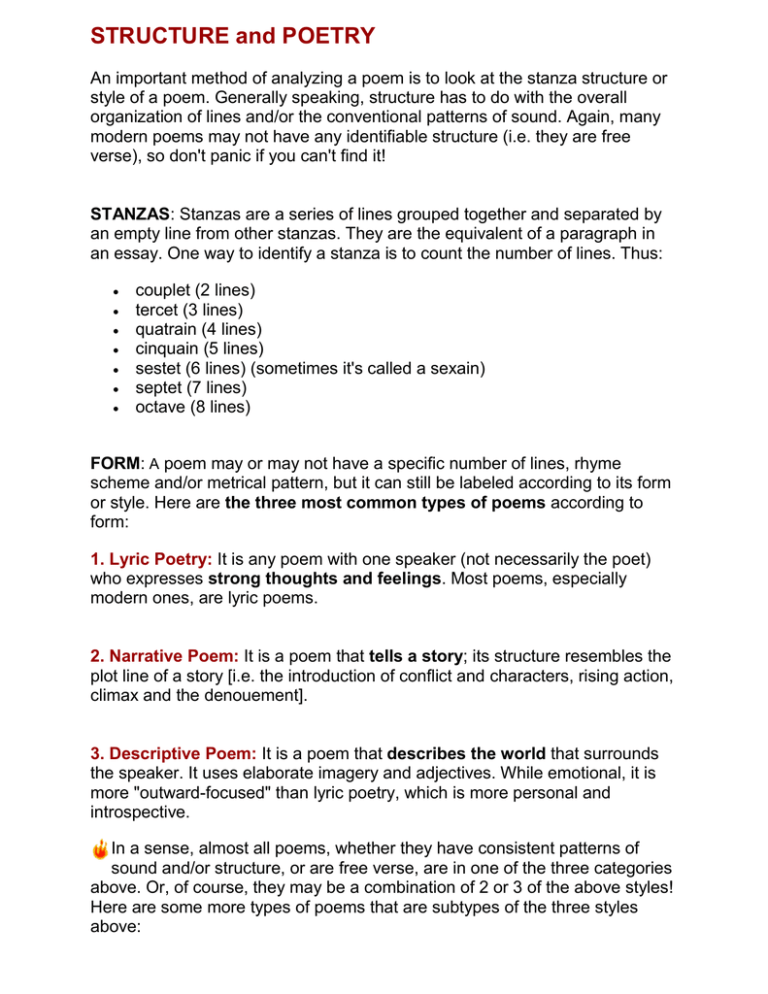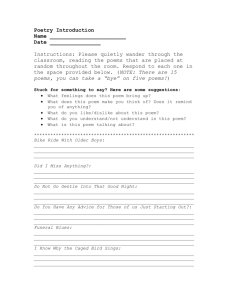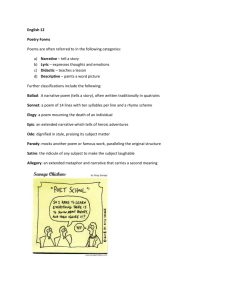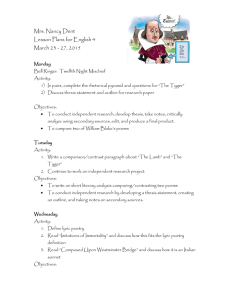Poetry Analysis: Stanza Structure, Forms, and Types
advertisement

STRUCTURE and POETRY An important method of analyzing a poem is to look at the stanza structure or style of a poem. Generally speaking, structure has to do with the overall organization of lines and/or the conventional patterns of sound. Again, many modern poems may not have any identifiable structure (i.e. they are free verse), so don't panic if you can't find it! STANZAS: Stanzas are a series of lines grouped together and separated by an empty line from other stanzas. They are the equivalent of a paragraph in an essay. One way to identify a stanza is to count the number of lines. Thus: couplet (2 lines) tercet (3 lines) quatrain (4 lines) cinquain (5 lines) sestet (6 lines) (sometimes it's called a sexain) septet (7 lines) octave (8 lines) FORM: A poem may or may not have a specific number of lines, rhyme scheme and/or metrical pattern, but it can still be labeled according to its form or style. Here are the three most common types of poems according to form: 1. Lyric Poetry: It is any poem with one speaker (not necessarily the poet) who expresses strong thoughts and feelings. Most poems, especially modern ones, are lyric poems. 2. Narrative Poem: It is a poem that tells a story; its structure resembles the plot line of a story [i.e. the introduction of conflict and characters, rising action, climax and the denouement]. 3. Descriptive Poem: It is a poem that describes the world that surrounds the speaker. It uses elaborate imagery and adjectives. While emotional, it is more "outward-focused" than lyric poetry, which is more personal and introspective. In a sense, almost all poems, whether they have consistent patterns of sound and/or structure, or are free verse, are in one of the three categories above. Or, of course, they may be a combination of 2 or 3 of the above styles! Here are some more types of poems that are subtypes of the three styles above: Ode: It is usually a lyric poem of moderate length, with a serious subject, an elevated style, and an elaborate stanza pattern. Elegy: It is a lyric poem that mourns the dead. [It's not to be confused with a eulogy.]It has no set metric or stanzaic pattern, but it usually begins by reminiscing about the dead person, then laments the reason for the death, and then resolves the grief by concluding that death leads to immortality. It often uses "apostrophe" (calling out to the dead person) as a literary technique. It can have a fairly formal style, and sound similar to an ode. Sonnet: It is a lyric poem consisting of 14 lines and, in the English version, is usually written in iambic pentameter. There are two basic kinds of sonnets: the Italian (or Petrarchan) sonnet and the Shakespearean (or Elizabethan/English) sonnet. The Italian/Petrarchan sonnet is named after Petrarch, an Italian Renaissance poet. The Petrarchan sonnet consists of an octave (eight lines) and a sestet (six lines). The Shakespearean sonnet consists of three quatrains (four lines each) and a concluding couplet (two lines). The Petrarchan sonnet tends to divide the thought into two parts (argument and conclusion); the Shakespearean, into four (the final couplet is the summary). Ballad: It is a narrative poem that has a musical rhythm and can be sung. A ballad is usually organized into quatrains or cinquains, has a simple rhythm structure, and tells the tales of ordinary people. Epic: It is a long narrative poem in elevated style recounting the deeds of a legendary or historical hero. Qualities of an Epic Poem: narrative poem of great scope; dealing with the founding of a nation or some other heroic theme requires a dignified theme requires an organic unity requires orderly progress of the action always has a heroic figure or figures involves supernatural forces written in deliberately ceremonial style Other types of poems include: Haiku: It has an unrhymed verse form having three lines (a tercet) and usually 5,7,5 syllables, respectively. It's usually considered a lyric poem. Limerick: It has a very structured poem, usually humorous & composed of five lines (a cinquain), in anaabba rhyming pattern; beat must be anapestic (weak, weak, strong) with 3 feet in lines 1, 2, & 5 and 2 feet in lines 3 & 4. It's usually a narrative poem based upon a short and often ribald anecdote.









